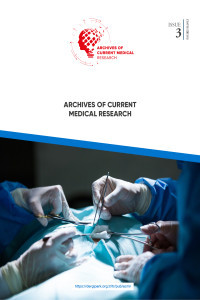Clinical and Functional Outcomes of Using Double-Row Transosseous Fixation Material in Advanced Age Treatment of Rotator Cuff Tears
Clinical and Functional Outcomes of Using Double-Row Transosseous Fixation Material in Advanced Age Treatment of Rotator Cuff Tears
___
- 1. Bunker T. Rotator cuff disease. Curr Orthopaed. 2002;16(3):223-33.
- 2. McKee MD, Yoo DJ. The effect of surgery for rotator cuff disease on general health status. Results of a prospective trial. J Bone Joint Surg Am. 2000;82-A(7):970-9.
- 3. Cole BJ, McCarty LP, Kong RW, Alford W, Lewis PB, Hayden JK. Arthroscopic rotator cuff repair: Prospective functional outcome and repair integrity at minimum 2-year follow-up. J Shoulder Elb Surg. 2007;16(5):579-85.
- 4. Yamaguchi K, Levine WN, Marra G, Galatz LM, Klepps S, Flatow EL. Transitioning to arthroscopic rotator cuff repair: the pros and cons. Instr Course Lect. 2003;52(1):81-92.
- 5. Codman E. Rupture of the supraspinatus tendon and other lesions in or about the subacromial bursa. The shoulder. 1934.
- 6. Mascarenhas R, Chalmers PN, Sayegh ET, Bhandari M, Verma NN, Cole BJ, et al. Is double-row rotator cuff repair clinically superior to single-row rotator cuff repair: a systematic review of overlapping meta-analyses. Arthroscopy. 2014;30(9):1156-65.
- 7. Xu C, Zhao J, Li D. Meta-analysis comparing single-row and doublerow repair techniques in the arthroscopic treatment of rotator cuff tears. J Shoulder Elbow Surg. 2014;23(2):182-8.
- 8. Kuroda S, Ishige N, Mikasa M. Reply to the letter to the editor: advantages of arthroscopic transosseous suture repair of the rotator cuff without the use of anchors. Clin Orthop Relat Res. 2014;472(3):1044-5.
- 9. Kilcoyne KG, Guillaume SG, Hannan CV, Langdale ER, Belkoff SM, Srikumaran U. Anchored transosseous-equivalent versus anchorless transosseous rotator cuff repair: a biomechanical analysis in a cadaveric model. Am J Sports Med. 2017;45(10):2364-71.
- 10. Goutallier D, Postel J-M, Radier C, Bernageau J, Zilber S. Long-term functional and structural outcome in patients with intact repairs 1 year after open transosseous rotator cuff repair. J Shoulder Elbow Surg. 2009;18(4):521-8.
- 11. Kim K-C, Rhee K-J, Shin H-D, Kim Y-M. Arthroscopic transosseous rotator cuff repair. Orthopedics. 2008;31(4):327-30.
- 12. Baudi P, Dani ER, Campochiaro G, Rebuzzi M, Serafini F, Catani F. The rotator cuff tear repair with a new arthroscopic transosseous system: the Sharc-FT®. Musculoskelet Surg. 2013;97(1):57-61.
- 13. Apreleva M, Özbaydar M, Fitzgibbons PG, Warner JJ. Rotator cuff tears: the effect of the reconstruction method on three-dimensional repair site area. Arthroscopy. 2002;18(5):519-26.
- 14. Goldberg B. Minimally invasive shoulder and elbow surgery. Med Sci Sports Exerc. 2007;39(9):1679.
- 15. Severud EL, Ruotolo C, Abbott DD, Nottage WM. All-arthroscopic versus mini-open rotator cuff repair: a long-term retrospective outcome comparison. Arthroscopy. 2003;19(3):234-8.
- 16. Weber S. All-arthroscopic versus mini-open repair in the management of tears of the rotator cuff: A prospective evaluation. Arthroscopy. 2001;17(suppl 1).
- 17. Kim S-H, Ha K-I, Park J-H, Kang J-S, Oh S-K, Oh I. Arthroscopic versus mini-open salvage repair of the rotator cuff tear: outcome analysis at 2 to 6 years’ follow-up. Arthroscopy. 2003;19(7):746-54.
- 18. Herrera MF, Bauer G, Reynolds F, Wilk RM, Bigliani LU, Levine WN. Infection after mini-open rotator cuff repair. J Shoulder Elbow Surg. 2002;11(6):605-8.
- 19. Mirzayan R, Itamura JM, Vangsness Jr T, Holtom PD, Sherman R, Patzakis MJ. Management of chronic deep infection following rotator cuff repair. J Bone Joint Surg Am. 2000;82(8):1115.
- 20. Roßbach BP, Jansson V, Pietschmann M, Müller P. Endoskopische Schultereingriffe: sicher und effizient. Orthopädie und Rheuma. 2014;17(5):28-36.
- 21. Weber SC, Abrams JS, Nottage WM. Complications associated with arthroscopic shoulder surgery. Arthroscopy. 2002;18(2):88-95.
- 22. Zhang Z, Gu B, Zhu W, Zhu L, Li Q. Arthroscopic versus mini-open rotator cuff repair: a prospective, randomized study with 24-month follow-up. Eur J Orthop Surg Traumatol. 2014;24(6):845-50.
- 23. Kim S-J, Kim S-H, Moon H-S, Chun Y-M. Footprint contact area and interface pressure comparison between the knotless and knot-tying transosseous-equivalent technique for rotator cuff repair. Arthroscopy. 2016;32(1):7-12.
- 24. Fealy S, Kingham TP, Altchek DW. Mini-open rotator cuff repair using a two-row fixation technique: outcomes analysis in patients with small, moderate, and large rotator cuff tears. Arthroscopy. 2002;18(6):665-70.
- 25. Park MC, ElAttrache NS, Tibone JE, Ahmad CS, Jun B-J, Lee TQ. Part I: Footprint contact characteristics for a transosseous-equivalent rotator cuff repair technique compared with a double-row repair technique. J Shoulder Elbow Surg. 2007;16(4):461-8.
- Yayın Aralığı: Yılda 3 Sayı
- Başlangıç: 2020
- Yayıncı: 14 Mart Tıbbiyeliler Derneği
Mehmet Ali CEYHAN, Miray TÜMER, Selahattin GÜRÜ, Gültekin KADI, Gültekin Günhan DEMİR
Selahattin GÜRÜ, Gültekin KADI, Begüm ÖKTEM, Mehmet KARAMERCAN
Renal Epithelioid Angiomyolipoma with Aggresive Progression: A Case Report and Literature Review
Emre ALTINTAŞ, Ali Furkan BATUR, Mehmet KAYNAR, Murat GÜL, Murat AKAND, Serdar GÖKTAŞ, Zeliha ÇELİK, Özcan KILIÇ
Unexpected Arrhythmia in a Young Patient: Hookah Smoking Triggered Atrial Fibrillation
Muhammed KESKİN, Tufan ÇINAR, Murat SELÇUK, Selami DOĞAN, Vedat ÇİÇEK, Ahmet Lütfullah ORHAN
Comparison of Suture-Button Versus HookPlate Fixation for Acromioclavicular Joint Injuries
Osman Yağız ATLI, Hüseyin Bilgehan ÇEVİK, Hakan ASLAN, Evrim DUMAN
Mehmet Cenk TURGUT, Serdar TOY, Mehmet KÖSE, Muhammed Çağatay ENGİN
Factors Affecting the Nutritional Habits of Cerebral Palsy Patients
Merve ÇALKIN KORKMAZ, Mehmet AĞIRMAN, Elif AY
Skin Findings Related to COVID-19, the Review of the Current Literature
Ezgi TUNCAY, Mustafa ÖZTÜRK, Ayşenur Nergiz TANIDIR, Burcu SENGÜVEN TOKÖZLÜ, Özge PAŞAOĞLU
